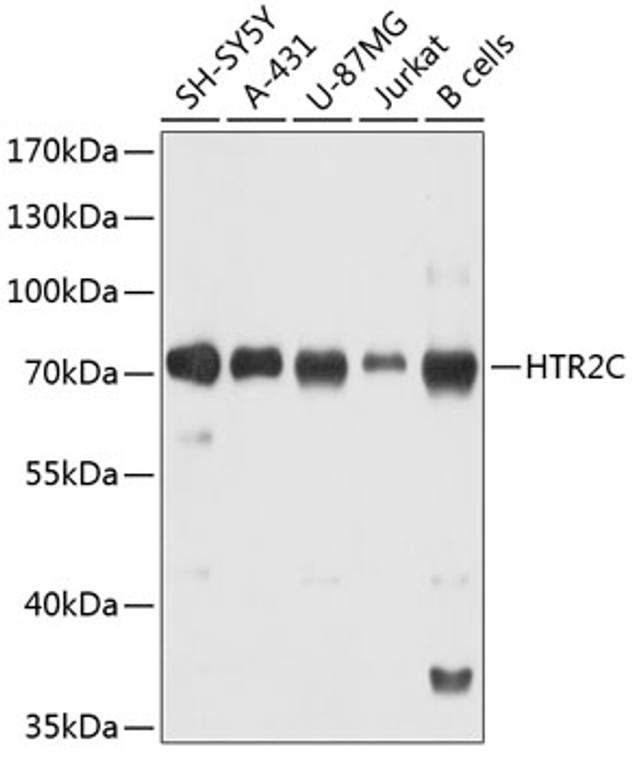| Host: |
Rabbit |
| Applications: |
WB/ELISA |
| Reactivity: |
Human/Mouse/Rat |
| Note: |
STRICTLY FOR FURTHER SCIENTIFIC RESEARCH USE ONLY (RUO). MUST NOT TO BE USED IN DIAGNOSTIC OR THERAPEUTIC APPLICATIONS. |
| Clonality: |
Polyclonal |
| Conjugation: |
Unconjugated |
| Isotype: |
IgG |
| Formulation: |
PBS with 0.02% Sodium Azide, 50% Glycerol, pH 7.3. |
| Purification: |
Affinity purification |
| Concentration: |
Lot specific |
| Dilution Range: |
WB:1:500-1:1000ELISA:Recommended starting concentration is 1 Mu g/mL. Please optimize the concentration based on your specific assay requirements. |
| Storage Instruction: |
Store at-20°C for up to 1 year from the date of receipt, and avoid repeat freeze-thaw cycles. |
| Gene Symbol: |
HTR2C |
| Gene ID: |
3358 |
| Uniprot ID: |
5HT2C_HUMAN |
| Immunogen Region: |
120-220 aa |
| Specificity: |
A synthetic peptide corresponding to a sequence within amino acids 120-220 of human HTR2C (NP_000859.2). |
| Immunogen Sequence: |
WPLPRYLCPVWISLDVLFST ASIMHLCAISLDRYVAIRNP IEHSRFNSRTKAIMKIAIVW AISIGVSVPIPVIGLRDEEK VFVNNTTCVLNDPNFVLIGS F |
| Tissue Specificity | Detected in brain. |
| Post Translational Modifications | N-glycosylated. |
| Function | G-protein coupled receptor for 5-hydroxytryptamine (serotonin). Also functions as a receptor for various drugs and psychoactive substances, including ergot alkaloid derivatives, 1-2,5,-dimethoxy-4-iodophenyl-2-aminopropane (DOI) and lysergic acid diethylamide (LSD). Ligand binding causes a conformation change that triggers signaling via guanine nucleotide-binding proteins (G proteins) and modulates the activity of downstream effectors. HTR2C is coupled to G(q)/G(11) G alpha proteins and activates phospholipase C-beta, releasing diacylglycerol (DAG) and inositol 1,4,5-trisphosphate (IP3) second messengers that modulate the activity of phosphatidylinositol 3-kinase and promote the release of Ca(2+) ions from intracellular stores, respectively. Beta-arrestin family members inhibit signaling via G proteins and mediate activation of alternative signaling pathways. Regulates neuronal activity via the activation of short transient receptor potential calcium channels in the brain, and thereby modulates the activation of pro-opiomelanocortin neurons and the release of CRH that then regulates the release of corticosterone. Plays a role in the regulation of appetite and eating behavior, responses to anxiogenic stimuli and stress. Plays a role in insulin sensitivity and glucose homeostasis. |
| Protein Name | 5-Hydroxytryptamine Receptor 2c5-Ht-2c5-Ht2c5-Htr2c5-Hydroxytryptamine Receptor 1c5-Ht-1c5-Ht1cSerotonin Receptor 2c |
| Database Links | Reactome: R-HSA-390666Reactome: R-HSA-416476 |
| Cellular Localisation | Cell MembraneMulti-Pass Membrane Protein |
| Alternative Antibody Names | Anti-5-Hydroxytryptamine Receptor 2c antibodyAnti-5-Ht-2c antibodyAnti-5-Ht2c antibodyAnti-5-Htr2c antibodyAnti-5-Hydroxytryptamine Receptor 1c antibodyAnti-5-Ht-1c antibodyAnti-5-Ht1c antibodyAnti-Serotonin Receptor 2c antibodyAnti-HTR2C antibodyAnti-HTR1C antibody |
Information sourced from Uniprot.org
12 months for antibodies. 6 months for ELISA Kits. Please see website T&Cs for further guidance







